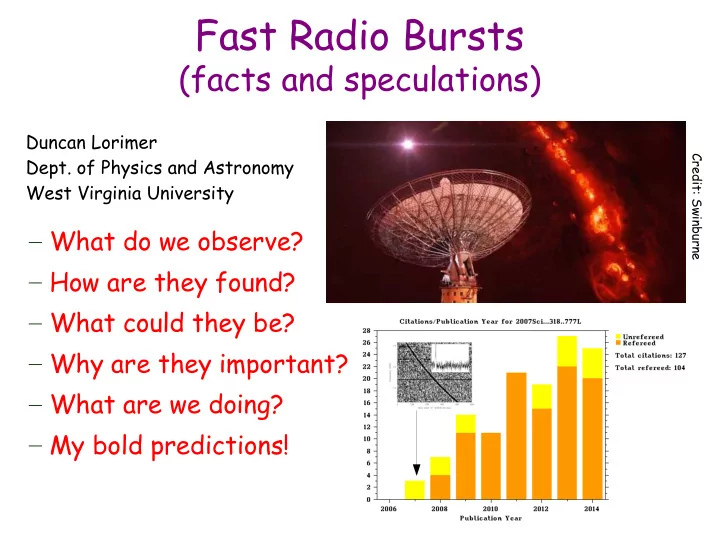

Fast Radio Bursts (facts and speculations) Duncan Lorimer Dept. of Physics and Astronomy C r e d West Virginia University i t : S w i n – What do we observe? b u r n e – How are they found? – What could they be? – Why are they important? – What are we doing? – My bold predictions!
What is observed? • 1+1+4+1+1=8 published • Peak flux > 0.5 Jy • L-band (1.4 GHz) • Highly dispersed • Pulse widths > few ms • Evidence for scattering • Singular events? • Different sky locations • No counterparts so far From Thornton et al. (2013)
Obligatory table of numbers FRB l b DM Width Flux 010724 300 -42 375 4.6 30 010621 25 -4 746 8.3 0.4 110220 51 -55 944 5.6 1.3 110703 81 -59 1104 1.4 0.5 110627 356 -42 723 4.3 0.4 120127 49 -66 553 1.1 0.5 121002 308 -26 1628 2 / 4 0.4 121102 175 -0.2 557 3 0.4
Compared to pulsar DMs ??? LMC SMC 47Tuc
Compared to pulsar DMs C r e d i t : J i m C o r d e s
How are they found? C r e d i t : m y w i f e
Example search-code output
Bright events are easily visualized
Faint events are harder to see C r e d i t : S c o t t R a n s o m
What could they be? C r e d i t : J - P M a c q u a r t Black: Parkes; Pink: SKA1-lo; Grey: SKA1-mid
What could they be? • Local – Atmospheric Peryton idea (Kulkarni et al. 2014) • Extra-terrestrial – Alien signals (Luan & Goldreich 2014) • Galactic – Flare stars (Loeb et al. 2014) • Extragalactic – Favored cosmic catastrophe (Cobbly et al. 2014)
Extragalactic source possibilities • Collapsing neutron stars • Evaporating black holes • Coalescing neutron stars • Coalescing white dwarfs • Magnetar flares • Supernovae • Giant pulses • Cosmic strings... Desperately need counterparts
What can we do with 'em? (assuming that they are extragalactic) • Measure the distance → origins • Measure the intergalactic DM • Measure turbulence in IGM • Probe missing baryons and DE • Measure the intergalactic B-field • Probe population at different redshifts
Probing the missing baryons C r e d i t : M c Q u i n n ( 2 0 1 4 )
C r e d i t : Z h o u e t a l ( 2 0 1 4 ) FRBs as cosmic rulers
What next? • Find bursts with other telescopes C r e d i t : S p i t l e r e t a l . ( 2 0 1 4 , i n p r e s s )
What next? • Find bursts with other telescopes • Find them at different frequencies
C r e d i t : T h o r n t o n e t a l . 2 0 1 3 Scattering in FRB 110220
What next? • Find bursts with other telescopes • Find bursts with other telescopes • Find them at different frequencies • Do as much as possible with existing ones Bannister & Marsden (2014)
What are people doing • Searching archival data • Follow-up on existing bursts • Realtime detectors on large/small dishes • Staring at the sky with interferometers Bold predictions • 2015: counterparts found • 2020: 100s FRBs found • 2025: 1000s of FRBs known • 2030: FRBs essential cosmological tools
Recommend
More recommend